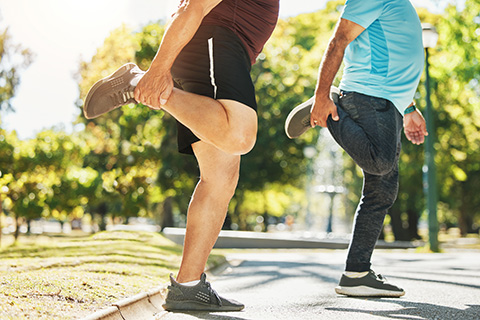A recent study claims that standing heel-raise training can generate greater hypertrophy compared to seated heel-raise exercise.
The triceps surae muscles play a key role in key movements such as walking, running, and jumping. In addition, as they are stabilizers of the body, their size and strength are related to the risk of falling. Yet this muscle does not respond to strength training. However, it is prone to atrophy with inactivity. A better understanding of effective training modalities for the triceps surae would be very useful in both sport and clinical settings.
Components of the triceps surae
The triceps surae is composed of the lateral gastrocnemius (LG), medial gastrocnemius (MG), and soleus (SOL) muscles. The LG and MG are biarticular muscles that cross the knee joint. Their ability to hypertrophy is influenced by muscle length during training. Previous studies have shown that training at greater muscle length produces greater hypertrophy in muscles, as is the case with the hamstrings or triceps brachii.
This research hypothesizes that standing heel-raise exercise would generate greater hypertrophy in the triceps surae compared to seated heel-raise exercise. Although both exercises are common in triceps surae training programs, a direct comparison of their hypertrophic effect has not been performed. Discovering their differences will help develop evidence-based training programs for the triceps surae and other muscles.

How was the study on triceps surae training conducted?
The research is based on an analytical model of standing heel-raise and seated heel-raise exercises, where the ranges and muscle actions of the triceps surae were determined. Fourteen untrained adults participated in the study. They performed calf-raise training with one leg in a standing position (knee extended) and the other leg in a seated position (knee flexed). Two training sessions per week were carried out for 12 weeks. Before and after the intervention, magnetic resonance images were obtained to assess the muscle volume of each and of the triceps surae.
After the training sessions, muscle volume increased considerably in all three muscles and in the entire triceps surae of both legs, except in the gastrocnemius muscles of the seated leg. Changes in muscle volume were mainly evident in the standing leg and to a lesser extent in the seated leg in the lateral gastrocnemius (12.4% vs. 1.7%), medial gastrocnemius (9.2 vs. 0.6%), and complete triceps surae (5.6% vs. 2.1%) but similar between legs in the soleus (2.1% vs. 2.9%).
In summary, if you want to enhance triceps surae hypertrophy, it’s time to modify your heel-raise training by leaning towards the standing position. This approach will bring more noticeable results and help you optimize your performance in daily activities and sports. Stay tuned for future research that will expand our understanding of this topic and improve our knowledge of the most effective ways to train the body’s muscles. With more efficient exercise and renewed energy, you will take firm steps toward greater physical performance and a better quality of life.
Continue your professional training
Have you ever thought of combining your passion for sports with a successful career in management? Look no further! Finally, the Universidad Internacional Iberoamericana (International Iberoamerican University, UNIB) offers the Master in Physical Activity: Sports Training and Management. This program will provide you with the knowledge and skills necessary to excel in the dynamic and competitive sports industry. Take the first step toward your future success by enrolling in this prestigious master’s degree program that will provide you with the tools to excel in the field of sports management.
Source: Triceps surae muscle hypertrophy is greater after standing versus seated calf-raise training

